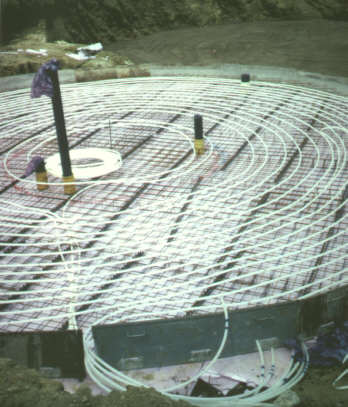Knowledge fuels change
For over a decade, Energypedia has shared free, reliable energy expertise with the world.
We’re now facing a serious funding gap.
Help keep this platform alive — your donation, big or small, truly matters!
Thank you for your support
Digester Heating
To achieve the optimum biogas yield, the anaerobic digestion needs constant environmental conditions, preferably close to the process optimum. The digester temperature is of prime importance. In temperate areas, a heating system and an insulation of the digester is necessary. Hence, the needed temperature for digestion can be reached and a loss of energy by transmission is compensated.
|
Heating system for a biodigester under construction (Germany) |
Because of the high costs for material and installation of a heating system, a low-cost biogas plant, as needed in developing countries, can only be build without heating. To boost the biogas yield for those plants, the building of a bigger digester to increase the retention time would be cheaper. A bigger digester reduces the required maintenance, while a heating system, increases maintenance requirements. A bigger digester serves also as a buffer for sediments, pH-variations and gas storage. For example, a fixed dome plant sized 50% bigger, is only 10% more expensive.
The mean surrounding temperature and it's seasonal variations are very important. Biogas plants without heating system work, therefore, only in warmer regions for the whole year. In regions with extreme temperature variations, for instance in Turkey (hot summer, cold winter), the biogas plant should be built under the stable. Hence the biogas yield would be lower in summer, but constant over the year and at the end higher. Before implementation, at least an approximated average temperature profile and expected extremes over the year should be available for the site.
A biogas plant with heating system and co-generation can be operated with process energy. Nevertheless the dimensioning of such a heating system is difficult, as the substrate, which has to be heated up, is not homogenous.
A guiding figure for a digester with a hydraulic retention time of 20 days is 270 W/m3 digester volume. The increasing of the hydraulic retention time makes it possible to reduce the heating power per volume. With a hydraulic retention time of 40 days the digester needs only 150 W/m3.
Following figures are for heating systems with a heating water temperature difference of 20 K:
| hydr. retention time | 40 days | 30 days | 20 days |
|---|---|---|---|
| temperature difference | 20 K | 20 K | 20 K |
| heating power | 150 kW/m3 | 210 kW/m3 | 270 kW/m3 |
A heating system located in the digester produces a thermal circulation, which is, especially for non-agitated digesters, very important.
An indirect energy transfer by heat exchanger is most common. Exceptions are steam injection, liquefying of solid manure with heated water and the heating by pre-aeration.
Internal and external heating systems
External heating systems have a forced flow on both sides. Due to the turbulent flow patterns of both media, a very good heat transportation can be reached. Therefore, the surface of the heat exchanger can be comparatively small. Nevertheless those systems cannot be recommended for non-agitated digesters.
The proper dimensioning of an internal heating system seems to be more difficult because of the different currents due to pumping, agitation, thermo-convection and the inflow of bio-mass.
Under-floor heating systems have been very popular, as they have no disturbing parts in the digester itself. Due to sedimentation and the resulting worsening of heat transportation into the digester, under-floor heating is no longer recommended. With the growth of digester volumes and the need of bigger heating systems, it is also more difficult to build under-floor heating big enough to provide the necessary heat.
Heating coils installed at the inner wall of the digester are a rather new practice. Heating coils made out of steel are much more expensive than heating coils out of plastic material (PE). Materials developed during the last years make such a system more stable while not increasing the costs of the heating system.
Another option is to construct two digesters connected in series, the first heated, the second unheated. The first digester can be used as sedimentation tank , in which the substrate is heated up. The second digester is well isolated to reduce loss of heat.
Back to "Construction"




















